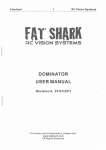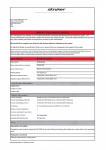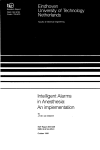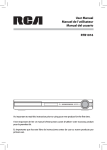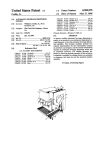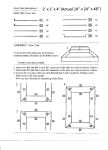Download Eiffel in Computer Language - Chair of Software Engineering
Transcript
=========EXOTICLANGUAGE
========OFTHE MONTH CLUB
--------
Eiffel: Applying the principles
of obiect~oriented design
iffel is a language
based on the principles of objectoriented design, augmented by features
enhancing correctness, extend ability, and
efficiency. Currently available on UNIX,
Eiffel includes a library of reusable
classes and tools for tasks such as automatic configuration management, documentation, and debugging.
Software quality involves trade-offs
among many factors.' Reusability, or the
ability to produce software components
that may be used in many different applications, is one of the more important
factors. Many of the same program patterns frequently recur, but actual reuse
of program modules is much less widespread than it ought to be. Another important factor is extendability: although
software is supposed to be soft, it is notoriously hard to modify software systems,
especially large ones.
Reusability and extendability allow for
less software to be written. Thus, presumably, more time may be devoted to
other goals-efficiency,
ease of use, etc.
In the long run, it may payoff to concentrate on these two factors; they were
indeed paramount in the design of EiffeJ.
Other design goals that played a significant part in developing Eiffel include
software correctness and robustness, portability, and efficiency in the context of
practical, medium-to-large-scale
developments.
To achieve reusability and extendability, the prinr;:iples of object-oriented
design provide the best-known technical
approach. Object-oriented design is the
construction of software systems as
structured collections of abstract data
. type implementations. The following
points are worth noting in this definition:
• The emphasis is on structuring a system around the classes of objects it manipulates rather than the functions it
performs.
• Objects are described as instances of
abstract data types--data structures
known from an interface rather than
through their representation.
• Basic modular units, called classes, describe implementations of abstract data
types.
• "Collection" reflects how classes
-------
::::::::::::=
E
should be designed: as units that are interesting and useful on their own, independent of the systems to which they
belong, and may be reused by many different systems. Software construction is
viewed as the assembly of existing
classes, not as a top-down process starting from scratch.
• "Structured" reflects the existence of
important relationships between classes,
particularly the multiple inheritance
relation.
A class represents an implementation
of an abstract data type: a set of runtime objects characterized by the operations available on it (which are the same
for all instances of a given class) and the
properties of these operations. These objects are called the class's instances.
Classes and objects should not be confused: classes are a compile-time notion,
whereas objects exist only at run time.
This difference is similar to the difference in classical programming between a
program and one execution of that
program.
A simple example of a class is ACCOUNT, which describes bank accounts.
Before showing the class, we describe
how it would be used by another class,
such as X, called a client. To use ACCOUNT, X may introduce an entity and
declare it of this type:
The term "entity" is preferred to "variable" as it denotes a more general notion.
An entity declared of a class type, such
as aecl, may· at any time during execution refer to an object (Figure 1); since
Eiffel is a typed language, this object
must be an instance of ACCOUNT or
(as I will discuss later) a descendant
class of ACCOUNT. An entity that does
not refer to any object is void. By default
(at initialization) entities are void; ob- .
jects must be created explicitly by an
instruction:
This instruction associates aecl with the
newly created object. Create is a predefined feature of the language.
Once aed has been associated with an
object, the features defined in AC-
aee/.open ("John "I;
ace I. deposit (50001;
If ace I.may_withdraw (3000) then
ace I.withdraw (3000)
end;
print (ace I.balancel
All feature applications use the dot
notation, as in entity-namejeature
_name. The two kinds of features include routines or operations, such as
open, deposit, may_withdraw. or withdraw, and attributes-data
items associated with objects of the class.
Routines are further divided into procedures and functions; only functions return a result. In the previous example,
may_withdraw is a function with an integer parameter, returning a Boolean result; the other three routines invoked are
procedures.
The example of class X does not show
whether in ACCOUNT balance is an attribute or a function without parameters.
This ambiguity is intentional. A class
such as X. a client of ACCOUNT, does
not need to know how a balance is obtained: it could be stored as an attribute
of every account object or recomputed by
a function from other attributes such as
the list of previous deposits and withdrawals. The choice between these representations is internal to ACCOUNT but
irrelevant to clients.
The following is a first sketch of how
ACCOUNT itself might look; line segments beginning with two dashes C--) are
comments:
<~nt,itY arid :qsso(iat~d:~bi~·~f:~
..e--tBonk
ACCOUrit-obleCII
class ACCOUNT export
open, deposit, may_withdraw,
withdraw, balance, owner
feature
balance: INTEGER;
minimum_balance: INTEGER is 1000;
owner: STRING;
open (who: STRING) is
--Assign the account to owner who
do
owner:=
who
end; --open
add (sum: INTEGER) is
--Add sum to the balance
-·(Secret procedure)
do
balance
:=
• Class invariants must be satisfied by
instances of a class at all times, or, more
precisely, after object creation and after
any call to the class's routine. They are
described in the invariant clause of a
class and represent general consistency
constraints imposed on all routines of a
class.
Assertions in Eiffel reflect the notion
of correctness already mentioned. Techniques for producing extendable and reusable components are of little interest
unless we convince ourselves these components are also correct and robust.
The ACCOUNT class may be rewritten with appropriate assertions:
bolonce+sum
end; ··deposit
deposit (sum: INTEGER) is
--Deposit sum into the account
do
add (sum)
end; ··deposit
withdraw (sum: INTEGER) is
·-Withdraw sum from the account
class ACCOUNT export ....(as before)
feature
..... Attributes as before:
..... balance, minimum_balance, owner
open
--as before;
add. ··as before;
deposit (sum: INTEGER) is
--Deposit sum into the account
require
do
>= 0
add (-sum)
end; -'withdraw
may_withdraw (sum:INTEGER):BOOLEAN
do
is
ensure
··Is it permitted to withdraw sum
-·from the account?
do
Result: = (balance> =
minimum_balance)
end; -·deposit
end ··class ACCOUNT
This class includes two clauses: feature, which describes the features of the
class, and export, which lists the names
of features available to clients of the
class. Nonexported features are consid·
ered secret. Here procedure add is secret, so accl.add (-3000) would be
illegal in X. Attribute minimum
_balance is also secret.
sum
add (sum)
balance = old balance + sum
;-·deposit
withdraw (sum: INTEGER) is
··Withdraw sum from the account
end
require
sum >= 0:
sum < = balance minimurrLbolance
do
odd {-suml
ensure
balance = old balance end ;--withdraw
may_withdrow ..... ·-as before
Create (initial: INTEGER)is
require
initial>
=
sum
minimurrLbolonce
do
------~
lasses are defined as abstract
C
============
data type implementations. What defines an abstract
data type, however, is not just the available operations but also the formal properties of these operations, which do not
appear in the previous example.
Eiffel enables programmers to express
formal properties of classes by writing
assertions, which may appear in the following positions:
• Routine preconditions express conditions that must be satisfied whenever a
routine is called. For example, withdrawal might only be permitted if it keeps the
account's balance on or above the minimum. Preconditions are introduced by
the keyword require.
• Routine postconditions, introduced by
the keyword ensure, express conditions
guaranteed to be true on routine return.
balance := initial
end·-Create
Invariant
balance> = minimurrLbalance
end--class ACCOUNT
Syntactically. assertions are Boolean
expressions with a few extensions, such
as the old notation. The semicolon (see
the precondition to withdraw) is equivalent to and but permits individual identification of the components, which is
useful for producing informative error
messages when assertions are checked at
run time.
Assertions may indeed be monitored at
run time; since such monitoring may penalize the performance, it is enabled on
option, class by class. (For each class,
two levels of monitoring are possible: preconditions only or all assertions). The
classes of the basic Eiffellibrary, widely
used in Eiffel programming, are protected by carefully written assertions. A violated assertion will trigger an exception.
Unless the programmer has written an
appropriate exception handler, the exception will cause an error message and
termination.
Independently of any run-time checking, however, assertions are powerful
tools for documenting correctness arguments: they make explicit the assumptions on which programmers rely when
they write program fragments they believe are correct. Writing assertions, especially preconditions and postconditions,
amounts to spelling out the terms of a
contract that controls the relationship between a routine and its callers. The precondition binds the callers, the
postcondition binds the routine. This
metaphor of programming as contracting
is a general and fruitful paradigm.2
Using contracts involves the risk that
they may be broken, which is where exceptions are needed.J•4 An exception may
arise from one of several causes. When
assertions are monitored, an assertion
violation will raise an exception. Another
cause is the occurrence of a hardwaretriggered abnormal signal, which might
arise from arithmetic overflow or a failure to find the memory needed for allocating an object.
Unless a routine has made specific
provisions to handle exceptions, it will
fail if an exception arises during its execution. A routine that fails triggers an
exception in its caller. However, a routine
may handle an exception through a rescue clause. This optional clause attempts
to patch things up by bringing the current object to a stable state (one satisfying the class invariant). Then it can
terminate in either of two ways:
• The rescue clause may execute a retry
instruction. This will cause the routine to
restart its execution from the beginning,
attempting again to fulfill the routine's
contract, usually through another strategy. Retry assumes the instructions of the
rescue clause-before the retry-have
attempted to correct the cause of the
exception.
• If the rescue clause does not end with
retry. the routine fails: it returns to its
caller, immediately signaling an exception. (The caller's rescue clause will be
executed according to the same rules.)
Note that a routine with no rescue
clause is considered to have an empty
rescue clause, so any exception occurring
during the routine's execution will cause
the routine to fail immediately. The principle underlying this approach is that a
routine must either succeed or fail. If it
fails, it must notify its caller by triggering an exception.
The Advanced
Programmer's Editor
That Doesn't Waste Your Time
•
•
•
•
•
•
•
Fast, EMACS-style commands-completely
reconFigurable
Run other programs without stopping Epsilon-concurrently!
C language support-FiX errors while your compiler runs
Powerful extension language
• Great on-line help system
MUltiple windows, Files
• Regular Expression search
Unlimited File size, line length • Supports large displays
30 day money-back guarantee • Not copy protected
Only S195
LUQsru
~
Software Ltd.
5843 Forbes Avenue
Pittsburgh, PA 15217
LAHEY SETS NEW
FORTRAN STANDARDS
LAHEY PERSONAL FORTRAN 77
$95
Low cost, Full 77 Standard, Debugger, Fast Compilation
F77L FORTRAN LANGUAGE SYSTEM
$477
For porting or developing, this Is the critics' choice.
"Editor's Choice"
"
the most robust compiler tested."
"
the most efficIent and productive FORTRAN
development tool for the DOS environment"
F77L-EM/32-bit
$895
PC Magazine
Micro/Systems
BYTE
F77L-EM/16-bit
$695
Break through the DOS 640K barrier. The most powerful PC Fortran
Language Systems for downloading or writing large programs.
PRODUCTIVITY TOOLS
Profller, ULI Mathematical Functions Library, Overlay Linker, TOOlkit,
Utility Libraries, Windows, Memory Boards, 80386 HummlngBoard.
IF YOU DEMAND THE VERY BEST, THEN YOU SHOULD BE USiNG LAHEY.
CALL US TO DISCUSS YOUR PC FORTRAN NEEDS.
CALL FOR NEW FEATURES INCLUDING MATH COPROCESSOR EMULATION
FOR INFORMATION OR TO ORDER:
1·800·548-4778
Lahey Computer Systems, Inc.
P.O. Box 6091, Incline Village, NV 89450
TEL: 702-831-2500 TLX: 9102401256
uilding software
components or
:::::::::::=
classes as implementations of abstract data types yields
systems with a solid architecture but
does not ensure reusability and extendability. However, certain Eiffel techniques help make components as general
and flexible as possible.
The first such technique is genericity,
which exists in different form in languages such as Ada but is new to objectoriented languages. Classes may have
generic parameters representing types.
The following examples come from the
basic Eiffel library:
------
TRUE
MULTITASKING
With
MultiDos Plus
"multitasking
for the
IBM-PC."
Ideal for developing applications·
in process control, data acquisition, communications, and other
areas. Check these features which
make MultlDos Plus an unbeatable value.
•
•
•
•
•
•
Run up to 32 programs concurrently.
Your software continues to run
under DOS. No need to learn a
new operating system.
Use the compilers you already
have. Supports software written in
most languages.
Operator commands to load / run
programs, change priority, check
program status. abort/suspend/
resume programs.
Programmatic Interface via INT ISH
for the follOWing.
• Intertask message communication. Send / receive / check meso
sage present on 64 message
queues.
• Task control by means of
semaphores. Get/ release / check
semaphores.
• Change priority·256 priority
levels.
• Suspend task for specified
Interval.
• Spawn and terminate external
and internal tasks.
• Disable/enable
multitasking.
• and morel
Independent foreground / background displays.
Access to DOS while applications
are running.
Hardware/Software
Requirements
IBM PC/Xf/AT or true clone. Enough
memory to hold MuItIDoa ••••• (48
KB) and all your application programs.
Also may need 4 or 16 KB memory
for "hidden screens" for each active
task. MS· DOS (or PC-DOS) 2.0 or
later operating system.
only:
$24.95
$99.95
OR
with source code
Outside USA add $5.00 shipping and h:uldling.
Visa and Mastercard orders only call
toll-free: 1-800-872-4566, ext. 350., or
send check or money order to:
NANOSOFT
13 Westfield Rd, Natick, MA 01760
MA orders add 5% sales tax.
B
ARRAY [T]
LlST[T]
LINKED_LIST [T]
These classes describe one-dimensional
arrays, general lists (without commitment as to a specific representation), and
lists in linked representation, respectively. Each has a formal generic parameter,
T, representing an arbitrary type. To use
these classes, you provide actual generic
parameters that may be either simple or
class types, as in the following
declara tions:
il: LIST {INTEGER};
00: ARRAY [ACCOUNT];
001: LIST [[ARRAY [ACCOUNTlJ --etc.
Another key reusability technique is
multiple inheritance. The basic idea is
simple: define a new class by combining
and refining existing classes, rather than
as a new entity defined from scratch.
The following is a typical example of
multiple inheritance from the basic Eiffel
library. LIST, as indicated, describes
lists of any representation. One possible
representation for lists with a fixed number of elements uses an array. Such a
class will be defined by combination of
LIST and ARRAY, as follows:
class FIXED_LIST
m export ....
Inherit
LIST [TJ;
ARRAY[T]
feature
...Speclfic features of fixed-size lists...
end-·closs FIXED_LIST
The inherit". clause lists the parents
of the new class, which is their heir. (The
ancestors of a class include the class itself, its parents, grandparents, etc. The
opposite term is "descendant.") Declaring FIXED_LIST as shown ensures all
the features and properties of lists and
arrays are applicable to fixed lists as
well.
Another example of multiple inheritance is extracted from a windowing sys-
tem based on a class WINDOW.
Windows have graphical featuresheight, width, position, etc.-with associated routines to scale them, move them,
and so on. The system permits windows
to be nested, allowing for hierarchical
features: access to subwindows and the
parent window, adding a subwindow, deleting a subwindow, attaching to another
parent, and so on. Rather than writing a
complex class that would contain specific
implementations for all these features, it
is preferable to inherit all hierarchical
features from TREE (one of the classes
in the basic Eiffel library describing tree
implementations) and all graphical features from a class RECTANGLE.
Multiple inheritance raises the possibility of name clashes. This problem is
solved in Eiffel by a rename construct,
which is also useful to provide locally
well-adapted names for inherited
features.
An important aspect of inheritance is
that it enables the definition of flexible
program entities that may refer to objects of various forms at run time, a phenomenon called polymorphism. This
capability is one of the distinctive features of object-oriented languages. In
Eiffel, it is reconciled with static typing.
The underlying language convention is
simple: an assignment of the form
a := b is permitted not only if a and b
are of the same type, but more generally
if a and b are of class types A and B,
such that B is a descendant of A.
This convention corresponds to the intuitive idea that a value of a more specialized type may be assigned to an
entity of a less specialized type, but not
the reverse. (As an analogy, consider ordering vegetables: asking for green vegetables and receiving a dish labeled
"vegetables" is not acceptable as it could
include carrots or another nongreen
vegetable.)
What makes polymorphism particularly powerful is two complementary facilities: redefinition and dynamic binding. A
class's feature may be redefined in any
descendant class; the type of the redefined feature (if an attribute or a function) may be redefined as a descendant
type of the original feature, and, in the
case of a routine, its body may also be
replaced by a new one.
Assume, for example, that the class
POLYGON, describing polygons, has
among its features an array of points representing the vertices and a function
perimeter returning a real result-the
perimeter of the current polygon, obtained by summing the successive distances bet~een vertices. An heir of
POLYGON may be:
class RECTANGLE export ... inherit
POLYGON redeflne perimeter
feature
--SpeciAc features
of rectangles,
such as:
side 1: REAL; side2: REAL;
perimeter: REAL is
--Rectangle-specific
version
do
Result ,= 2 • (sidel + side2J
end;--perimeter
... ather RECTANGLE leatures ...
It is appropriate to redefine perimeter
for rectangles since a simpler and more
efficient algorithm exists.
Other descendants of POLYGON may
also have their own redefinitions of
perimeter. Dynamic binding means that
the version to use in any call is determined by the run-time form of the parameter. Consider the following class
fragment:
light of the contracting metaphor described earlier. Redefinition and dynamic
binding introduce subcontracting: for example, POLYGON subcontracts the implementation of perimeter to
RECTANGLE when applied to any entity that refers at run-time to a rectangle
object. An honest subcontractor is bound
by the contract accepted by the prime
contractor: it may not impose stronger
requirements on the clients but may accept more general requests; hence the
possibility for the precondition to be
weaker. Also, it must achieve at least as
much as promised by the original contractor, but may achieve more; hence the
possibility for the postcondition to be
stronger.
deferred class VEHICLEexport
dues-paid, valid_plote, register, ...
feature
dues-paid (year,INTEGERJ,
BOOLEAN Is•.•end;
If you think fOU can buy a
better C compiler, don't.
We'llbuy it for you.
p: POLYGON; r: RECTANGLE;
........ p.Create; r.Create;
.
if c then p ,= rend;
print (p.perimeterJ
The assignment p := r is valid because of the rule in the previous example.
If condition c is false, p will refer to an
object of type POLYGON when p.perimeter is evaluated, so the polygon algorithm will be used. In the opposite case,
however, p will dynamically refer to a
rectangle, so the redefined version of the
feature will be applied. This capability is
known as dynamic binding.
Dynamic binding provides a high degree of flexibility and generality. Its advantages include the ability to request an
operation (here the computation of a figure's perimeter) without knowing what
version of the operation will be selected;
the selection occurs only at run time.
This is essential in large systems, where
many variants of operations may be
available and each component of the system should be protected against variant
changes in other components.
Assertions are another tool in Eiffel
for controlling the power of the redefinition mechanism. If no precautions are
taken, redefinition may be dangerous:
how can a user be sure evaluation of
p.perimeter will not in some cases return
the area, for instance?
One way to maintain the semantic
consistency of routines throughout their
redefinitions is to use preconditions and
postconditions, which are binding on redefinitions. More precisely, any redefined
version must satisfy a weaker or equal
precondition and ensure a stronger or
equal postcondition than in the original.
Thus, by making the semantic constraints explicit, routine writers may limit the amount of freedom granted to
eventual redefiners.
These rules should be understood in
A
n important extension of the in::::::::::::=
heritance
mechanism is provided by deferred
classes. A deferred class is a class containing at least one deferred routine; a
routine is declared as deferred to express
that implementations of the routines will
be provided only in descendants. For example, a system used by the Department
of Motor Vehicles to register vehicles
could include a class of the form:
------
Buy Let's c® with csd
forjust $75. If you're
not satisfied, get
'furbo C or QuickC. Free.*
T
"
Why are we making this Incredible offer? Because We'reabsolutely certain Lets C and csd C Source Debugger are the best C programming tools
you can own.
Rest assured that. like Its competition, Lets C features incredibly fast
In-memory compilation and produces extremely tight. high quality code.
The differences lie In how much faster you can perform other programming
chores.
Our debugger. for example. can cut development time in half. But thats
not all:
"csd is close to the ideal debugging environment ... a definite aid to
learning
C and an indispensable
tooljor program development."
And comparatively speaking:
"No debugger
package ... a serious shortcoming."
-William G. Wong.BITE
is included in the Turbo C
-Michael Abrash. Programmer's Journal
Unlike our competition. Lets C includes Its own full-featuredassembler.
features documentation with complete examples and technical support with
complete answers-theflrst time you call.
LET'S
c:
csd:
: ~~~~a~~!~~fl.I~I~e~~:
~~e: editor
·r~~::~11~~
~~~\r
i~e~~~~
memory
model
• Integrated envirOflmenl Of command
line inlerlace
• 8087 sensing and 5uPPDl'I
• Fuil UNIX compalibilily and complete
libraries
• Many powerful utilities including make.
assembler.iHchlver
• MlcroEMACS full screen editor with
source code included
• Supporled by dozens of third party
libraries
• Oebug in C source code. not assembler
• Provides separate source. evaluaUoo.
· ~~R[:~
~~~
t%~~~~~~~~~Smonllor
variableS
.
• Can Interactively evaluate any C expression
• Can excculeany C function in your program
• Trace back lurx::llon
So Ifyou're thinking about bUyingany other C compiler,think again.
But this offer ls only available fora limited time. So think fast. Andsee your
softwaredealerorcalll-800-MWC-1700soon. (1-312-4 72-6659 In illinois.)
1b exchange Lets C and csd forThrbo C orgulckC. return roglstrallon card within 15 days of purchase
date notify Mark WIUIBmsCompany that you are returning pi'oducls and receive a return authorization
nu~ber. Products must be returned wllhln 30 days of purchase dale or withIn 30 days of shipping dale
on telephone orders.
'iIDJ
11111
Mark
Williams
Company
1430 West Wrightwood, Chlcago,lIIinois 60614. 312-472-6659
Q
1988 Mark Williams Company
volid-plale (year:/NTEGER):
BOOLEAN is...end;
register Iyear: INTEGER) Is
-·Register vehicle for year
require
dues-paid
lye or)
deferred
ensure
valicLplate lye or)
end;--register
... Other features ...
end
This example assumes that no single
registration algorithm is applicable to all
types of vehicles; the exact procedure to
follow depends on the type of vehicle
considered: passenger car, motorcycle,
truck, e~c. However, the same precondition and postcondition are applicable to
all types of vehicles. The solution is to
treat register as a deferred routine, making VEHICLE a deferred class. Effective
versions of this routine are given in descendants of class VEHICLE: for example CAR, TRUCK, etc.
A deferred class may not be instantiated: v.Create is illegal if v is an entity
declared of type VEHICLE. But such an
entity may be assigned a reference to an
instance of a nondeferred descendant of
VEHICLE.
For example, assuming CAR and
TRUCK provide effective definitions for
all deferred routines of VEHICLE, the
following will be correct:
if "some test" then v
else v:= end;
v.register (1988)
:=
C
Deferred classes are particularly useful
for applying Eiffel as a design language
rather than just for implementation.
The
first version of a system may be given as
a set of deferred classes whose purpose
may be described by assertions. This is
achieved with dynamic binding. Depending on the outcome of a test, the appropriate version or register will be used at
run time.
===========
E
iffel runs on
UNIX System V,
-----4.2BSD, and
XENIX, and has been ported to about
15 different architectures. The compiler
uses C as an intermediate language, giving Eiffel the potential to be portable to
any environment supporting C. (The task
of making Eiffel portable to VAX/VMS
is under way.)
The openness of Eiffel's implementation deserves mention. Eiffel's classes are
meant to be interfaced with code written
in other languages. This is reflected by
the optional external clause that, in a
routine declaration, lists external subprograms used by the routine. For example, a square root routine might rely on
an external function:
sqrt (x: REAL, eps: REAL): REAL is
--Square root of x with precision eps
require
x >= 0; eps > 0
external
csqrt (x: REAL, eps: REAL):REAL
name "sqrt" language "CO'
do
Result:=
REALIA COBOL DRIVES
THE HIGH-SPEED DESKTOP
Our competitors will tell you that performance
they'lI want you to bUy faster hardware-don·t.
is secondary-it's
not. Or
Thousands of programmers
know how much difference Realia COBOL makes
every day. in their own productivity and their users' satisfaction. Realia COBOL
is not only the fastest-compiling
COBOL for the PC or PS/2 (2 to 10 times
faster than the other PC CaBaLs). It also produces the tightest. fastest
executable programs (4 to 70 times faster than the others).
Call for your copy of the Realia COBOL 3.00 Benchmark Report. Or ask for a
free evaluation copy of the prOduct-we'll
also send you the benchmark
program. so you can compare the compilers for yourself.
RIAII~
10 South RIverside Plaza. Chicago. IL 60606 • (312) 346-0642 • Telex 332979
CIRCLE 46 ON READER SERVICE CARD
86
COMPUTER LANGUAGE.
MAY 1988
csqrt (x, eps)
ensure
abs (Resu(t 1\2-x)
end··sqrt
<= eps
The optional name ... subclause caters to
the various naming conventions of other
languages.
The construction of systems in Eiffel is
supported by a set of development tools.
Most important are the facilities for
automatic configuration management integrated in the compilation command es
(Eiffel System). When a class C is compiled, the system automatically looks for
all classes on which C depends directly
or indirectly (as client or heir) and re-
compiles those whose compiled versions
class may be a Cllent alone 01 ItS Oescendants) and, in the case of the client relation, may involve cycles. But Eiffel's
solution frees programmers from having
to keep track of changed modules to
maintain the consistency of their systems. An algorithm avoids many unneeded recompilations by detecting
modifications that do not impact class interfaces. In practice, this algorithm prevents a chain reaction of recompilations
in a large system when a feature implementation is changed in a low-level class.
Eiffel's environment also contains debugging tools: tools for run-time assertion checking, a tracer and symbolic
debugger, and a viewer for interactive exploration of the object structure at run
time.
A documentation tool, short, produces
a summary version of a class that shows
the interface as available to clients: the
exported features and, in the case of routines, the header, precondition, and postcondition. The manual for the basic
Eiffellibrary
contains Eiffel documentation produced almost entirely from output generated by short.l Such
documentation is essentially obtained for
free and, even more importantly, is guaranteed to be consistent with the documented software as the documentation is
extracted from it. This should be contrasted with classical approaches, where
software and documentation are viewed
as separate products.
A postprocessor integrated in es performs various optional modifications on
the generated C code: removing of unnecesary routines, simplifying of calls to
nonpolymorphic routines, and in-line expansion of simple routines. One of its
main options is the generation of a
stand-alone C package from an Eiffel
system. The package comes with a make
file and a copy of the run-time system. It
may be ported to any environment supporting C and some primitive system
functions. This cross-development
facility
is particularly interesting for developers
who use Eiffel to design and implement
their software but deliver it to their customers in C form: Eiffel need not be
available on the target environments.
The basic Eiffellibrary
is a repertoire
of classes covering many important data
structures and algorithms. The library
enables programmers to think and write
in terms of lists, trees, stacks, hash tables, etc., rather than arrays, pointers,
flags, and the like.
Recent Eiffel developments include :l
through the network ot eXlstmg c asses.
These tools rely on on a set of graphical
library classes, based on the X Windows
package from Massachusetts Institute of
Technology (Cambridge, Mass.).
I believe Eiffel is the first language to
combine the powerful ideas of objectoriented languages with the modern concepts of software engineering. These capabilities are available to software
developers in an environment offering the
facilities required to develop serious
software .•
RI\fBtft"rb"~"'''''
~"4'''''"I~<.lU''''''''t ..•,,~
o.IVl+/""I1
VJ
Pascal, Ada and Modula-2. 1988 (to
appear).
4. Meyer, Bertrand. Object-Oriented Software Construction. Englewood Cliffs, N.J.:
Prentice-Hall. 1988.
5. Interactive Software Engineering Inc., Eiffel User's Manual, Technical Report
TREI5/UM, 1986.
Bertrand Meyer is president of Interactive Software Engineering Inc.• Santa
Barbara. Calif. a company that produces and distributes CASE tools.
Now COBOL Programmers
Can Do Formatted Screens
Quickly and Easily .. with SCREENIO.
Realia COBOL • Micro Focus COBOL • IBM COBOLl2
SCREENIO is a high-performance, COBOL-specific screen manager for the Personal Computer and compatibles, It's powerful, offers an impressive array of features, yet is easy to use.
SCREENIO was written by experienced COBOL professionals and represents a truly
COBOL approach to screen management on the PC;
Design and Revise Screens Painlessly with Our Panel Editor.
Use our interactive Panel Editor Facility to design your screens with a Wh~t.you-See-Is-WhatYou-Get approach. You can easily modify and experiment with screen Ia.yQ4t~';'.Typetitles and
descriptive information on the screen, draw lin,c:§and boxes usingtJ1e'~~f~Q?ffuovement keys,
and paint the colors you want using the cUisor,'keys or block:fti~hiot{'~: Use all 256 color
combinations
on your screens.
..".,::."S;:>{t,':":;
Programming;with
,'. ,y~,;,>';,;,.i'
SCREE~I()is
\'
Easy.
You can display your screen,and,~cc;\lpt
dat~>WiH:._gsfew as two statements; a COPY
and a CALL SCREENIO statement
in the PROCEDURE DIVISION. SCREENIO
linked with your application just as any
other COBOL subroutine WOUldbe;,',,)"
panelname in your WORKIN'G:SIpR.:A.GE§ERION,
is
Yes, we've always done windows::.$CREENIO
supports Edit Masks, Automatic Error
Detection and Editing, HighSpe~d Video, Hot-Fields, Key Redefinition, Foreign Language
Capability, Custom T(ibbingOrder, Color Control at Runtime, PC Speaker Control, and
much, much more. A'BMS Mapset Import is available. Most programmers are amazed at
how easy it is to build flashy applications using SCREENIO and COBOL.
Our Support is Outstanding.
We provide superb telephone support. Upgrades are distributed to licensed users automatically for the first year. There are no Runtime Fees-the code you develop is yours to distribute
freely.
We'll Send You a Free Demonstration
Diskette.
This limited version of our Panel Editor shows how you design panels.
Because it's written with COBOL and SCREENIO, it shows the kind
of features and performance you can expect in your applications.
SCREENIO 2.1 is only $400 plus shipping. Ask about our
other programming tools and package deals, too. In a
hurry? Most orders are delivered within 24 hours!
Northern Compullng Consultants
P.O. Box 020897 • Juneau, Alaska 9980
(907) 780·6464 • TELEX510 601 4951 (Norcom









